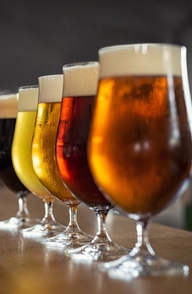Start 14-Day Trial Subscription
*No credit card required

What Is Light Beer and Why Is It So Popular?
Unravel the secrets of crafting a refreshing lower-calorie brew, exploring the meticulous brewing process and evolving styles. Whether you're a beer enthusiast or just curious, dive into the world of light beer for a satisfying drinking experience
In the vast and diverse world of beers, one term that consistently surfaces in discussions is "light beer." Renowned brands like Coors in the U.S. and Tennent's in Scotland have embraced the trend, making light beers a popular choice for modern drinkers. But what exactly is light beer, and what sets it apart in the brewer's realm? In this story, we'll delve into the intricacies of brewing to unravel the secrets behind light beer.
Crafting the Formula
At its essence, light beer is a beverage boasting a lower alcohol by volume (ABV) content than traditional brews. However, its definition goes beyond reduced alcohol levels; it involves a meticulously crafted formula with fewer calories and carbohydrates. Originating in the late 1960s, the birth of light beer aimed to provide a lighter alternative without compromising on taste, offering a refreshing option for calorie-conscious beer enthusiasts.
Brewing Lightness: How It's Made
The brewing process for light beer is a meticulous endeavor focused on reducing calorie and carbohydrate content while maintaining a balanced and enjoyable taste. Here's an overview of how light beer is typically brewed:
Ingredients Adjustment: Brewers fine-tune the grain bill, often using less malt or substituting it with adjuncts like rice or corn, decreasing fermentable sugars and lowering alcohol content.
Mashing and Fermentation: Grains are mashed to convert starches into sugars, creating wort. During fermentation, yeast is added to convert sugars into alcohol, with adjustments for a lower alcohol content.
Temperature Control: Careful fermentation temperature control guides yeast to produce fewer complex sugars and less alcohol, achieving a lighter body and crisp taste.
Extended Conditioning: After fermentation, the beer undergoes conditioning for maturation and clarification, ensuring a smooth and clean flavor profile.
Filtration and Carbonation: Thorough filtration removes remaining solids, and carbonation is added to achieve the desired level of fizziness.
Quality Control: Strict quality control measures are implemented throughout the brewing process for consistency in taste and quality.
Evolving Light Beer Styles
The evolution of light beer has witnessed breweries experimenting with various styles and flavors. Some opt for lighter versions of popular beer types, such as lagers or pilsners, catering to diverse palates. Craft breweries, known for innovation, contribute their unique twists and characters to the trend, adding variety to the light beer landscape.
A Growing Niche: Light Beer in the UK
In the United Kingdom, light beer has found a steady niche in the market, resonating with a broad spectrum of consumers. Its presence in pubs, supermarkets, and online retailers underscores its popularity among beer enthusiasts nationwide.
Light Beer Unveiled
A light beer is more than just a reduced-alcohol alternative; it's a testament to innovation and adaptability within the brewing industry. Beyond its calorie count, its appeal lies in providing a refreshing and enjoyable drinking experience while accommodating diverse lifestyles and preferences. Whether enjoyed at a social gathering or savored during a leisurely moment, light beer continues to shine in the ever-evolving world of brewing. Cheers to the art and science behind the lightness!



